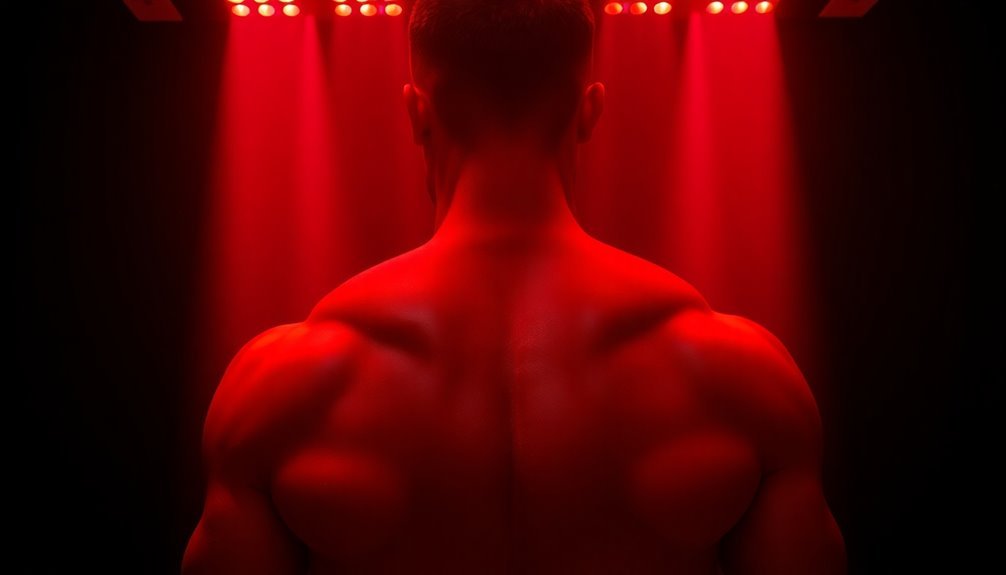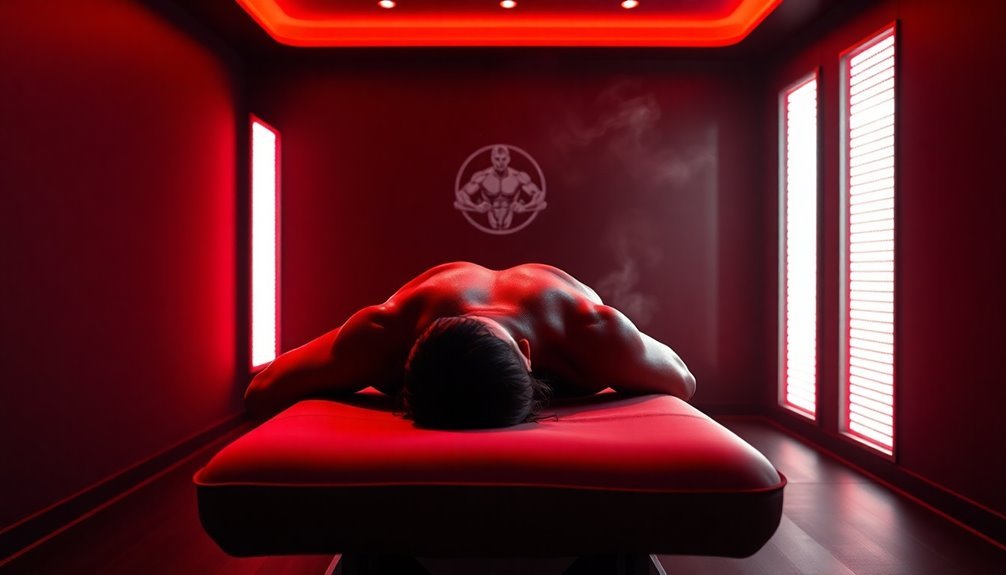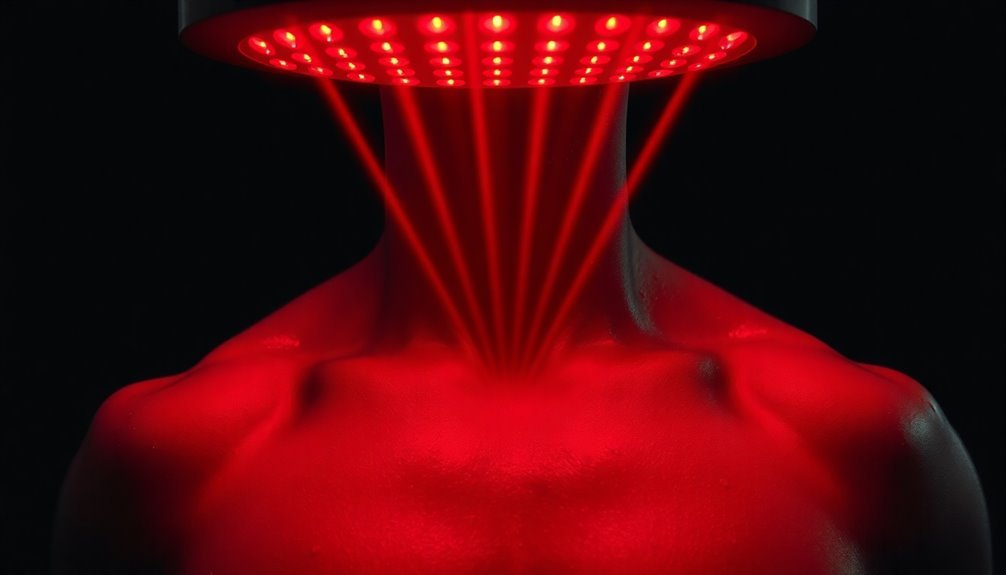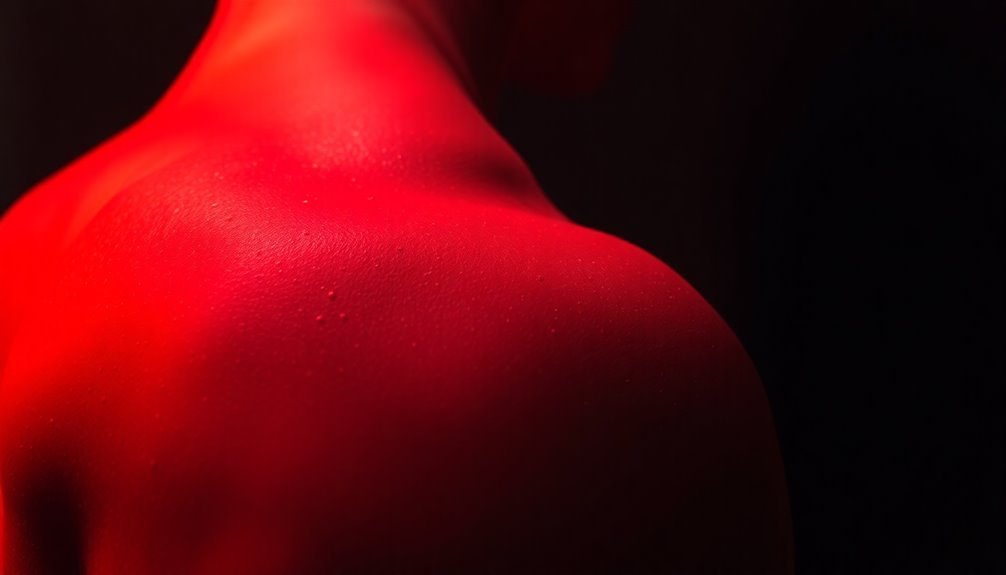Red light therapy's seven key wavelengths between 640-950 nm work together to accelerate your muscle recovery and boost athletic performance. When you expose your muscles to these therapeutic rays, they stimulate your mitochondria to produce more ATP, enhance blood flow, and reduce inflammation. You'll experience faster healing, less soreness, and improved strength gains from your workouts. The light penetrates deep into your tissue, promoting collagen synthesis and supporting muscle stem cell development. For ideal results, you'll want to apply red light both before and after exercise while staying properly hydrated. Understanding how each wavelength contributes to your recovery can maximize your training potential.
Understanding Red Light's Healing Power

The remarkable healing power of red light therapy lies in its ability to penetrate deep into muscle tissue and trigger cellular repair mechanisms. When you expose your muscles to red light, it stimulates your mitochondria – the cellular powerhouses – to produce more ATP, the energy currency your cells need for repair and recovery.
You'll benefit from improved circulation as the red light causes your blood vessels to dilate, delivering more oxygen and nutrients to your recovering muscles. This enhanced blood flow helps remove waste products and reduces inflammation, which is particularly beneficial if you're dealing with chronic inflammatory conditions or post-workout soreness. Regular evening treatments can help regulate sleep patterns and promote more restorative rest.
What makes red light therapy especially effective is its dual action on both cellular energy and tissue repair. As your cells receive more energy through increased ATP production, they're better equipped to accelerate healing processes.
You'll notice reduced muscle fatigue and faster recovery times, allowing you to maintain a more consistent training schedule. The therapy's non-invasive nature means you can integrate it into your recovery routine without worrying about side effects or drug interactions, making it an ideal choice for both athletes and fitness enthusiasts seeking natural recovery solutions.
Red Light Before Exercise Benefits
Building on red light therapy's healing properties, its pre-workout application offers remarkable performance advantages. When you expose your muscles to red light before exercise, you'll experience increased blood flow and oxygenation, preparing your body for peak performance while reducing injury risks. Professional volleyball players demonstrated greater muscular endurance when using this therapy before training sessions.
You'll notice significant improvements in your workout quality, as red light therapy helps delay muscle fatigue and increases your time-to-exhaustion. Studies show higher peak torque measurements and enhanced muscle activity in athletes who use this treatment before training. You'll be able to complete more repetitions and maintain better form throughout your session.
The benefits extend beyond physical performance. You'll experience improved mental focus and clarity, helping you visualize your goals and maintain better concentration during your workout.
For maximum results, you should use red light therapy both before and after your sessions, ensuring direct exposure to target areas.
The therapy's effectiveness is particularly notable in athletic performance, as it reduces oxidative stress and enhances oxygen uptake. You'll burn more fat during aerobic exercise and recover faster, making each workout more productive and sustainable.
Post-Workout Recovery With Light

After pushing your muscles to their limits, red light therapy emerges as a powerful tool for accelerating recovery and reducing post-workout soreness. The therapy's ability to enhance cellular energy production and decrease inflammation makes it particularly effective for combating delayed onset muscle soreness (DOMS).
You'll want to apply the therapy for at least 15 minutes following your workout, using wavelengths between 640-950 nm. For ideal results, adjust the dosage based on the muscle group you're targeting: 20-60 joules for smaller muscles and 60-300 joules for larger ones. Each LED should output 10-35 mW without overheating to guarantee safe and effective treatment.
The science behind post-workout red light therapy is compelling. It works at the cellular level by stimulating your mitochondria to produce more ATP, unlike traditional recovery methods such as heating pads. Many researchers use data analysis tools to measure and validate the effectiveness of this treatment.
You'll experience improved blood circulation, faster tissue repair, and enhanced muscle endurance. Regular sessions can substantially reduce recovery times and improve overall performance.
For best results, incorporate red light therapy into your post-workout routine a few times per week, especially after intense training sessions that typically lead to muscle fatigue and soreness.
Strength Enhancement Through Red Therapy
Recent scientific breakthroughs have revealed red light therapy's remarkable impact on muscle strength and performance. Studies show impressive gains, including a 55% increase in leg press performance and a 52% improvement in grip strength among participants who combined their workouts with red light treatments.
You'll get the best results by applying red light therapy for 20 minutes before your strength training sessions. For endurance activities, using it both pre- and post-workout can triple your performance improvements.
The closer you position yourself to the light source, the deeper it penetrates your tissues, reducing the time needed for effective treatment. Growth hormone production increases significantly during these sessions.
The strength gains from red light therapy stem from its effects at the cellular level. It boosts your ATP production, stimulates mitochondrial function, and enhances blood flow to your muscles.
These improvements lead to better muscle coordination and reduced oxidative stress, allowing you to train harder and longer.
When you use red light therapy consistently, you'll notice significant improvements in both strength and endurance. You'll experience less muscle fatigue during workouts and recover faster, enabling more productive training sessions and better overall athletic performance.
Dehydration Prevention Using Light Therapy

During your red light therapy sessions, you'll want to pay special attention to your hydration levels since the treatment can enhance your body's natural moisturizing processes and cellular function.
Your body's ability to absorb and retain moisture improves with red light therapy, which directly impacts your muscle recovery and overall performance potential. The therapy activates fibroblasts to boost collagen production, enhancing the skin's moisture-retention capabilities.
If you're dehydrated, you won't get the full benefits of the therapy, as your muscles need proper hydration to effectively repair and strengthen during recovery periods.
Hydration During Light Sessions
Proper hydration supercharges the effectiveness of red light therapy while protecting your body during treatment sessions. When you're well-hydrated, your blood flows more efficiently, delivering oxygen and nutrients to tissues being treated by red light. This enhanced circulation helps your cells produce more ATP, boosting their energy production and repair capabilities.
Staying hydrated and incorporating clinically proven wavelengths during treatments ensures optimal benefits. You'll want to drink plenty of water before, during, and after your light therapy sessions. This helps regulate your body temperature and prevents overheating while supporting your kidneys' natural filtration processes.
Your skin will also benefit from internal hydration, becoming more receptive to red light's healing effects.
To maximize your results, maintain consistent hydration throughout the day. You're not just drinking water for immediate effects – you're supporting your body's long-term response to red light therapy.
Pay attention to your fluid intake and look for signs of dehydration like dark urine or dry mouth. If you're exercising or using red light therapy for muscle recovery, you'll need even more water to compensate for fluid loss through sweating.
Performance Impact When Dehydrated
Through extensive research, dehydration emerges as a critical factor that can severely impact your athletic performance, even at minimal levels. When you lose just 2% of your body weight through dehydration, you'll notice significant declines in your exercise capacity and endurance. Sprint performance can drop by up to 45% with just a 2.5% body weight loss.
Your body's ability to regulate temperature diminishes, causing your core temperature to rise faster and your muscles to fatigue more quickly.
Red light therapy can help combat these dehydration effects by enhancing your body's cellular function and blood flow. You'll benefit from improved ATP production and better oxygen delivery to your muscles, which becomes essential when you're dealing with dehydration's negative impacts. The therapy's ability to reduce inflammation and oxidative stress helps protect your muscles from additional strain when they're not properly hydrated.
To maximize your performance, you'll need to combine red light therapy with proper hydration strategies. Without adequate hydration, you risk experiencing decreased flexibility, muscle cramps, and impaired breathing. Your endurance can drop dramatically – what might typically be a 121-minute exercise session could be cut to just 55 minutes when you're dehydrated. Remember, the therapy works best when your body is well-hydrated.
Mitochondrial Function And Muscle Repair
Mitochondria power up muscle repair through complex cellular processes that are essential for recovery and growth. These cellular powerhouses drive energy production through oxidative phosphorylation and the TCA cycle, making them vital for muscle regeneration.
When you're healing from a workout or injury, your mitochondria increase their numbers during the differentiation phase, supporting muscle repair and remodeling. The extracellular matrix remodeling supports proper muscle function and regeneration during recovery.
Red light therapy can boost your mitochondrial function by targeting specific wavelengths (660nm and 850nm) directly into muscle tissue. This non-invasive treatment enhances ATP production and accelerates recovery by improving blood flow and cellular regeneration.
- Your mitochondrial function naturally declines with age, reducing muscle stem cell effectiveness
- Mitochondrial dynamics control how muscle stem cells expand and differentiate after injury
- PGC-1 and mtTFA proteins regulate mitochondrial production during muscle regeneration
- Red light therapy stimulates mitochondrial respiration and reduces inflammation
- Oxidative muscles maintain better mitochondrial health, protecting against age-related decline
Understanding mitochondrial function is key to optimizing your recovery. By supporting these cellular powerhouses through proper nutrition, exercise, and treatments like red light therapy, you'll enhance your body's natural repair mechanisms.
Blood Flow Optimization Methods

Blood flow optimization plays a critical role in muscle recovery and performance enhancement. You'll find several effective methods to enhance blood circulation, with Blood Flow Restriction (BFR) therapy emerging as a cutting-edge technique. Using pneumatic cuffs to partially restrict blood flow, BFR helps you build strength and muscle mass even with lighter weights, making it particularly valuable during injury recovery.
If you're looking for traditional approaches, you can boost blood flow through strategic exercise programming and proper nutrition. You'll want to maintain adequate hydration while limiting substances that impair circulation, such as nicotine and excessive caffeine.
Physical therapy techniques, including therapeutic massage and heat applications, can further enhance your blood flow.
For enhanced recovery between intense training sessions, you might consider Neuromuscular Electrical Stimulation (NMES). This method uses controlled electrical impulses to increase blood flow to specific muscle groups, helping reduce fatigue and accelerate recovery.
Remember to incorporate dedicated recovery days into your routine, focusing on light activities that promote circulation without overtaxing your system. By combining these methods with proper sleep and nutrition, you'll create ideal conditions for muscle repair and growth.
Frequently Asked Questions
Can Red Light Therapy Help With Old Muscle Injuries and Chronic Pain?
Yes, you'll find red light therapy effectively treats old muscle injuries and chronic pain. It'll reduce inflammation, boost healing, increase blood flow, and stimulate cellular repair while providing long-lasting pain relief.
How Long Should Each Red Light Therapy Session Last for Optimal Results?
You'll want to aim for 10-20 minutes per session. Start with shorter sessions if you're new, then gradually increase duration. For chronic pain or muscle injuries, extend sessions to 15-20 minutes per area.
Is It Safe to Combine Red Light Therapy With Other Recovery Methods?
Yes, you can safely combine red light therapy with other recovery methods like rest and compression. However, you'll get the best results using red light therapy alone, rather than combining it with cold therapy.
What Wavelengths of Red Light Are Most Effective for Muscle Recovery?
You'll get the best muscle recovery results using wavelengths between 600-850 nanometers, with 630-660nm targeting inflammation and 808nm showing significant benefits. Near-infrared light also penetrates deeper for enhanced healing.
Does Skin Color or Body Composition Affect Red Light Therapy Effectiveness?
Yes, both factors matter. If you have darker skin, you'll need extra caution due to increased light sensitivity. Your body composition can affect light penetration depth, potentially impacting the therapy's effectiveness.
In Summary
Red light therapy offers you powerful ways to enhance your muscle performance and recovery. You'll find it's most effective when you combine pre-workout sessions with post-exercise treatments. By boosting your mitochondrial function and optimizing blood flow, you're giving your muscles the best chance to repair and strengthen. Don't forget to stay hydrated while using these treatments – they'll work even better when you're properly fueled.





Leave a Reply